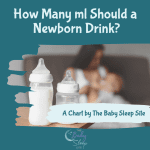
As newborns, babies seem to eat, sleep, and poop all day – every day. But, as your baby gets older, you may be wondering how much your baby should be eating, how often, and how many ounces by age. Keep in mind that milk should be your baby’s primary form of nutrition for the first year. Even after you’ve begun to offer solid foods, your baby’s milk intake should not decrease much, if at all. Also, babies are very good at self-moderation, so it is usually unnecessary to limit your baby’s milk intake for fear of him or her becoming overweight. Your baby’s growth and development depend on a large consumption of fat and calories.
These baby feeding charts for breastfeeding babies, formula-fed babies, and solids will help guide you to know if your baby is eating enough and how to help your baby sleep through the night sooner rather than later. Additionally, you may want to bookmark this page for future reference or pin it on Pinterest.
Quick Links:
Breastmilk Feedings and Amounts by Age
All breastfed babies need between 20-35 ounces of breast milk per day, on average. In younger newborns and up to 2-3 months old, your baby should breastfeed on-demand, which usually means every 2-3 hours.
If you are pumping, breastmilk bottles vary in size from 3 to 6 ounces, usually, with 4 ounces being the average size once a baby is at least 3-4 months old. Keep in mind that some babies simply have larger appetites than others. The most important aspect is that your baby’s weight gain stays on his or her growth curve. Do not withhold milk from your baby in fear he or she will become overweight. Babies are very good at self-moderation and should be fed when hungry.
How Many Times a Baby Breastfeeds in 24 Hours
Keep in mind that the number of times your baby breastfeeds in a 24-hour period will depend on the combination of:
a) how much milk your baby can hold in their stomach (i.e. stomach capacity).
b) how much milk you can store in your breasts (which has nothing to do with breast size).
c) your baby’s personality as well as if they have any digestion issues such as reflux.
We find babies who have reflux tend to eat more frequent, smaller meals. Also, some baby’s personalities are to overfill themselves while others eat until content and stop. My two boys were different than one another. While my first son would only ever eat 4-ounce bottles when we weren’t breastfeeding, his brother would take up to 5 to 5 1/2 ounce bottles at times. They were just different and even as my first son got older, he would simply NOT overeat or overfill his stomach and is still this way to this day.
Here is a handy baby feeding chart with breastmilk amounts by age, though keep in mind that many breastfeeding mothers feed their babies on-demand throughout their breastfeeding journey. This is just a rough guide to consider, especially if you feel like you are having to feed your baby excessively given his or her age.
If you ever have any concerns about your baby and your baby’s feeding habits, please be sure to seek out a healthcare provider and/or lactation consultant.
| Age | # of feedings per day / 24 hours | Feeding Frequency | Average Bottle Sizes (if applicable) | Night Feedings |
|---|---|---|---|---|
| 0-4 weeks/1 month | on-demand | on-demand* | ~2-3 ounces / 60-90 ml | on-demand |
| 5-8 weeks/2 months | on-demand | every 2-3 hours** | ~2-4 ounces / 60-120 ml | 3-4 |
| 9-12 weeks/3 months | ~8-10 | every 2-3 hours | 3-4 ounces / 90-120 ml | 2-3 |
| 13-16 weeks/4 months | ~6-10 | every 2-3 hours | 3-4 ounces / 90-120 ml | 2-3 |
| 5 months | ~6-10 | every 2-3 hours | 3-4 ounces / 90-120 ml | 2, maybe 3 |
| 6 months | ~6-9 | every 3 hours | 4-5 ounces / 120-150 ml | 1-2 |
| 7 months | ~5-8 | every 3-4 hours | 4-6 ounces / 120-180 ml | 1-2 |
| 8 months | ~5-8 | every 3-4 hours | 4-6 ounces / 120-180 ml | 1, maybe 2 |
| 9 months | ~5-8 | every 3-4 hours | 4-6 ounces / 120-180 ml | 1 |
| 10 months | ~4-6 | every 3-4 hours | 4-6 ounces / 120-180 ml | 0-1 |
| 11 months | ~4-6 | every 3-4 hours | 4-6 ounces / 120-180 ml | 0 |
| 12 months | ~4-6 | every 3-4 hours | 4-6 ounces / 120-180 ml | 0 |
* If your baby goes longer than 4 hours without eating, be sure to wake him or her to feed them.
** Many newborns cluster feed in the evenings, which means they may nurse every hour for several hours or practically remain on the breast for several hours. Some say they are “tanking up” for the night.
You may also be interested in:
Formula Feeding Amounts by Age
Formula fed infants typically need 2 1/2 ounces or 74 ml of formula for each pound of weight, on average. Some babies have larger appetites than others, though. I have worked with a lot of families, personally, and some babies take small bottles and consume around 24 oz a day total while others consume over 30 oz. The most important thing to remember is that your baby should stay on his or her own growth curve.
In the newborn days, it’s important to feed your baby on-demand whenever he or she shows signs of hunger. As your baby grows older, you can consider putting your baby on a schedule.
While some parents and babies thrive on schedules, some people prefer to allow the daily routine to be flexible. Keep in mind that the more your baby eats during the day, the sooner your baby will sleep through the night.
Here is a formula-feeding chart to tell you the average frequency and bottle sizes of formula by age, but keep in mind that some babies eat a variable amount at different times of the day. You should use this chart simply as a guide while also adapting your daily routine to fit your unique baby.
If you ever have any concerns about your baby and your baby’s feeding habits, please be sure to seek out a healthcare provider.
| Age | # of feedings per day / 24 hours | Feeding Frequency | Average Bottle Size | Night Feedings |
|---|---|---|---|---|
| 0-4 weeks | on-demand | on-demand* | ~2-4 ounces / 60-120 ml | on-demand |
| 5-8 weeks | 6-7 | every 3 hours | ~4 ounces / 120 ml | 2-3 |
| 9-12 weeks/3 months | 5 | every 3 hours | 4-6 ounces / 120-180 ml | 2, maybe 3 |
| 13-16 weeks/4 months | 5 | every 3-4 hours** | 4-6 ounces / 120-180 ml | 1-2 |
| 5 months | 4-5 | every 3-4 hours | 6-7 ounces / 180-210 ml | 1-2 |
| 6 months | 4-5 | every 3-4 hours | 6-8 ounces / 180-240 ml | 0-1 |
| 7 months | 4-5 | every 3-4 hours | 6-8 ounces / 180-240 ml | 0*** |
| 8 months | 4-5 | every 3-4 hours | 6-8 ounces / 180-240 ml | 0 |
| 9 months | 4-5 | every 3-4 hours | 6-8 ounces / 180-240 ml | 0 |
| 10 months | 3-5 | every 3-4 hours | 6-8 ounces / 180-240 ml | 0 |
| 11 months | 2-4 | every 3-4 hours | 6-8 ounces / 180-240 ml | 0 |
| 12 months | 2-3 | every 3-4 hours | 6-8 ounces / 180-240 ml | 0 |
* If your baby goes longer than 4 hours without eating, be sure to wake him or her to feed them.
** Not all babies get to 4 hours between milk feedings by this age or ever. Some babies will always eat every 3 hours until 9-10+ months old.
*** Some formula-fed babies still eat at night even past 6 months old, especially if they have reflux.
You may also be interested in:
Solid Foods by Age
As you start solids, your baby’s milk intake should not decrease much, if at all, until 10+ months old when he or she is eating 3 solid meals per day plus one snack. For the first year, solid food is a lot about practice and introducing a variety of flavors and textures. Keep in mind that until your baby is consuming significant amounts of solid food, starting solids won’t necessarily help your baby sleep. In fact, so many sleep problems have nothing to do with hunger that starting solids doesn’t change sleep whatsoever.
Here is a baby feeding chart for solid foods. Keep in mind that if you are practicing baby led weaning, whether by choice or because your baby doesn’t like pureed foods, your baby will likely consume a lot less solid food than other babies his or her age. That is just fine, as milk should still be your baby’s primary source of nutrition.
If you ever have any concerns about your baby and your baby’s feeding habits, please be sure to seek out a healthcare provider.
| Age | Grains (per day) | Fruit (per day) | Vegetables (per day) | Meat and Dairy (per day) |
|---|---|---|---|---|
| Birth-5 months | None | None | None | None |
| 6 months (1 solid feeding per day) | 1-2 tablespoons dry infant cereal, mixed with breastmilk or formula | 1-2 tablespoons pureed fruit | 1-2 tablespoons pureed vegetables | None |
| 7-8 months (2 solid feedings per day) | 1-6 tablespoons dry infant cereal, mixed with breastmilk or formula | 1-6 tablespoons pureed/mashed fruit | 1-6 tablespoons pureed/mashed vegetables | Meat: 1-2 tablespoons pureed/mashed protein (offer at 8 months) Dairy: 1/4-1/2 cup yogurt or cottage cheese; 1 oz. shredded cheese |
| 9-10 months (3 solid feedings per day) | 2-4 tablespoons dry infant cereal, mixed with breastmilk or formula. 1-2 servings other grains* | 4-8 tablespoons mashed/chopped fruit | 4-12 tablespoons mashed/chopped vegetables | Meat: 2-6 tablespoons mashed/chopped protein Dairy: Same as 7-8 month recommendations. |
| 11-12 months (3 solid feedings per day) | Same as above, except increase “other grains” to 2 servings | 6-8 tablespoons mashed/chopped fruit, or 1/2 cup diced | 6-12 tablespoons mashed/chopped vegetables, or 1/2 – 3/4 cup diced | Meat: 2-6 tablespoons mashed/chopped protein, or 1/4 cup diced Dairy: Same as 7-8 month recommendations. |
* 1 serving of “other grains” = 1/2 slice of bread, 2 crackers, 1/2 cup Cheerios, or 1/2 cup whole wheat pasta
You may also be interested in:








